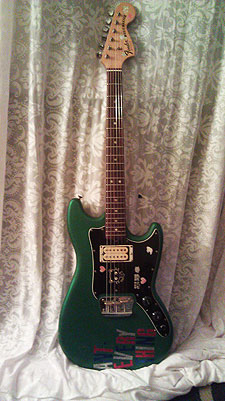Want To Start An Instant Argument? Let’s Talk About ’70s Fenders!
Published on December 5th, 2011 in: Dancing Ourselves Into The Tomb, Issues, Music, Over the Gadfly's Nest |Another notable Fender debuting in the ’70s was the Musicmaster Bass, introduced in 1971, a short-scale instrument similar to the Mustang Bass. As with the guitars sharing their model names, the Musicmaster is a lower-rent affair with a two-saddle, toploading (as opposed to string-through-body) bridge and an overall plainer appearance. Oddly enough, the Musicmaster Bass actually appears to have been outfitted with the same pickup as the Musicmaster guitar—a six-pole Stratocaster pickup, with a solid cover that hid the fact that the pickup was actually not designed for a bass at all. While it seemed to work well enough, a considerable number of Musicmaster Basses I’ve seen—including the ’73 my daughter owns—have replaced pickups. While they’re decent basses to begin with, in my experience they really come to life when equipped with a good, properly (read: professionally) installed Precision or Jazz Bass pickup. Some acts I’ve noticed sporting Musicmaster Basses of late include Giant Sand as well as Polly Harvey and John Parish on the A Woman A Man Walked By tour.
As pop culture fetish items to be collected, invested in, and obsessed over, it’s easy to be somewhat dismissive of ’70s Fender gear as “players”—good, solid workhorse instruments to be used, not hung on a wall or displayed in glass cases as so many of their ’50s and ’60s predecessors are. Of course, that would be somewhat unfair to the better examples of Fender artistry—even deep in the CBS era—many of us know and love.

My ’77 Musicmaster guitar
Also, there’s the simple economics of supply and demand. Even though Fender mass-produced guitars and amps then (as now, and as they did prior, for that matter), there are only so many left to go around, and the prices of pre-CBS Fenders became prohibitive to the average player long ago. Ironically, it’s not uncommon to find the same people who referred to ’70s Fenders as “junk” ten to twenty years ago while hawking ’50s Strats for obscene prices now hyping those “junk” guitars for several thousand dollars for their “vintage mojo.” Even in today’s horrible economy, many vintage dealers routinely price even mid to late ’70s Fender guitars at several thousand dollars, and those obscene prices for pre-CBS Fenders have become stratospheric. Bad pun aside, it’s not uncommon to take a casual glance at the websites of certain esteemed vintage dealers and see ’50s and even ’60s Fenders that cost as much as my house, making even grossly inflated prices for Seventies stuff seem like bargains in comparison. That said, with a little effort, great deals are still to be had for savvy shoppers willing to find them.
As to whether ’70s Fender products are good, bad, or ugly . . . in all fairness, the answer is yes to all and more. Like Fenders before and since, there’s much variation from one to the next—even in identical models. While it may seem obvious, the state of repair of any instrument—especially those now 30+ years old—makes a difference as well, and there’s at very least anecdotal evidence for almost any position regarding them.
Speaking of anecdotal evidence: I once played in a band with a bassist who used a 1977 Musicmaster bass. Admiring his bass when we first met, I mentioned I had a similar Musicmaster guitar, only to find out he did as well, a match for his bass. It turned out the serial numbers of our two Musicmasters were less than five apart—they literally were probably made the same day.
Eventually, he brought his to rehearsal, I brought mine, and we compared the two. While his was stock, in decent repair, played well enough, and sounded respectable, my own was somehow just livelier. The original finish on his was much thicker than mine, which had been refinished at least twice—it was a dull natural when I got it, and I did a less-than-stellar job giving it an ill-advised sparkly green paint job in my teens. Also, my Musicmaster came to me with a humbucking pickup installed, replacing the original singlecoil.
It’s impossible to say for certain why mine seemed more resonant—it may have been that way the day it left the factory. It may have been because it lacked the dipped-in-plastic finish of my bandmate’s. It definitely wasn’t the humbucker—the wiring was shoddy and such that only one coil was actually on, I later discovered. The saddles on mine were rusty and the adjustment screws were always loose, too.
Basically, the lovable hunk of junk I paid $75 or so for in a pawn shop was, in comparison to his, like the Millennium Falcon of guitars—not much to look at, but she’s got it where it counts. It was just somehow better. Not that my bandmate’s was bad, in fact it was a fine instrument as well. “Greenie” just has a certain special something about it, a certain something may be the result of the undoing of some of its typically CBS-era features.
At the end of the day, art isn’t really about the tools, of course, even if those tools are fun to obsess over and spend way too much time discussing online. That said, Fender made some fine tools then, and many of then play, look, and sound as good as anything they’ve made before or since. If they were (and still are) good enough for Keith Richards . . .
Time limit is exhausted. Please reload the CAPTCHA.